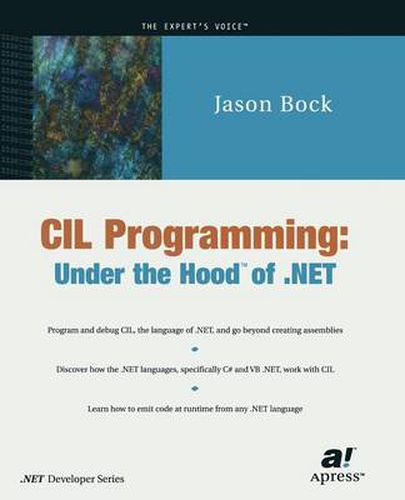Readings Newsletter
Become a Readings Member to make your shopping experience even easier.
Sign in or sign up for free!
You’re not far away from qualifying for FREE standard shipping within Australia
You’ve qualified for FREE standard shipping within Australia
The cart is loading…






This title is printed to order. This book may have been self-published. If so, we cannot guarantee the quality of the content. In the main most books will have gone through the editing process however some may not. We therefore suggest that you be aware of this before ordering this book. If in doubt check either the author or publisher’s details as we are unable to accept any returns unless they are faulty. Please contact us if you have any questions.
Most .NET developers will use a high-level language, such as C# or VB .NET, to develop their systems. However, the core language of .NET is the Common Intermediate Language, or CIL. This language is the language of .NET-whatever is allowed by the .NET specifications can be done in CIL, and it can do much that C# and VB .NET cannot. Understanding how the CIL works will give .NET developers a deep, language-independent insight into the core parts of .NET. Furthermore, such knowledge is essential for creating dynamic types, a powerful part of the .NET Framework. In this book, Bock covers the essentials of programming the CIL. First, he discusses the basics of what .NET: assemblies are, how manifests fit into the picture, and much more. Bock then shows how to create assemblies in .NET-this will cover the ilasm directives and CIL opcodes, and how these are used to define assemblies, classes, field, methods, and method definitions. Bock also covers how C# and VB .NET and other non-MS languages emit CIL and how they differ. Finally, Bock shows how one can create dynamic assemblies at runtime via the Emitter classes.
$9.00 standard shipping within Australia
FREE standard shipping within Australia for orders over $100.00
Express & International shipping calculated at checkout
This title is printed to order. This book may have been self-published. If so, we cannot guarantee the quality of the content. In the main most books will have gone through the editing process however some may not. We therefore suggest that you be aware of this before ordering this book. If in doubt check either the author or publisher’s details as we are unable to accept any returns unless they are faulty. Please contact us if you have any questions.
Most .NET developers will use a high-level language, such as C# or VB .NET, to develop their systems. However, the core language of .NET is the Common Intermediate Language, or CIL. This language is the language of .NET-whatever is allowed by the .NET specifications can be done in CIL, and it can do much that C# and VB .NET cannot. Understanding how the CIL works will give .NET developers a deep, language-independent insight into the core parts of .NET. Furthermore, such knowledge is essential for creating dynamic types, a powerful part of the .NET Framework. In this book, Bock covers the essentials of programming the CIL. First, he discusses the basics of what .NET: assemblies are, how manifests fit into the picture, and much more. Bock then shows how to create assemblies in .NET-this will cover the ilasm directives and CIL opcodes, and how these are used to define assemblies, classes, field, methods, and method definitions. Bock also covers how C# and VB .NET and other non-MS languages emit CIL and how they differ. Finally, Bock shows how one can create dynamic assemblies at runtime via the Emitter classes.